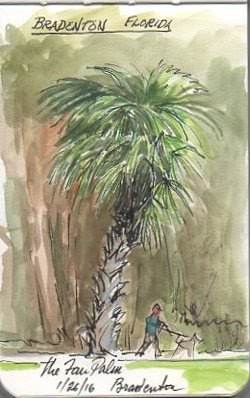Late last month while considering another Inktober--the
worldwide event of drawing and posting a daily pen and ink drawing--I decided
instead to do a metalpoint drawing every day of this month, posting the
results. We're now about a week into the month and so far I've managed to
follow through. Of course, metalpoint is a much different drawing discipline
than inking. Both invove drawing with materials that aren't easily erased, only
effaced; both are considered antique, if not archaic; and both have a limited
following. No matter. The point is to work with the medium repetitively,
becoming familiar with its strengths and limitations.
Working with metalpoint requires an exacting approach, a
carefully prepared surface, and considerable time. Whatever support one uses
for metalpoint drawings, the surface must have some "tooth," a mildly
abrasive surface, to allow the metal to be rubbed onto it. Soft metals like
silver, gold, even lead, work fine and make marks that vary in darkness and
color. Silver makes a cool, medium-dark line while gold makes warm but paler
lines. The need for an exacting approach is similar to ink--another unforgiving
medium--since erasure isn't really possible. Depending on the support and
surface you can erase metal marks with exceptionally-fine sandpaper, but
usually the surface is damaged too much. And since even silverpoint marks can
only be deposited in a limited range of values, shading and volume rendering
need care with line weights and hatching, both of which require considerable
time. I'm hoping that a month of working with silvepoint will give me much
experience and advance my skills with the medium.
These are a few of the daily metalpoints from the past week.
 |
"Breaker Boy," silverpoint on board, 3x5
|
The first silverpoint for October, "Breaker Boy," was actually finished September 30. It is a drawing on a piece of gessoed hardboard, which provides a good surface with enough tooth for silverpoint. The image is from an antique photo of boys who worked in deep-shaft coal mines in Appalachia at the turn of the 20th century. These school age boys worked 60 hour weeks and had no schooling. Breaker boys worked to remove impurities from coal that had been broken into lumps--by hand. Eventually child labor laws stopped the practice of children in coal mines.
 |
Figure study, silverpoint on paper, 7x9
|
The figure drawing on the left, from a reference photo, shows the fine lines you can achieve with a sharp stylus. The challenge with this drawing was exactness. For me that meant long study before making a single mark, then extreme care, placing a mark and then leaving it alone. The idea was to do each piece of the figure accurately the first time. In the end that approach means very little fiddling with the drawing, cleaner lines, and a good figure. The paper used for this drawing was prepared by brushing a liquid silverpoint ground onto each page of a sketchbook. The paper weight was enough to allow application of the ground without cockling, and the ground is more abrasive than gesso, which allowed for very thin yet dark silver lines.
 |
After Buonarotti, silverpoint, 5x6.5
|
The drawing below is another silverpoint drawing on paper but the paper itself accepts metal without preparation. Unlike the thinner paper in my sketchbook, this paper has a bit of "give," or compressibility, which actually prevents making exceptionally dark lines, plus a sharp point will incise the paper, which I wanted to avoid. This drawing is a detail of a sculpture by Michelangelo that he abandoned. It was to be part of his own tomb but the stone was flawed and he quit working on it long before he died. A student kept it. This is a detail of the head of one of the figures, which is said to be a self portrait.
As the month progresses my plan is to continue working with a variety of supports. Most of these works will be silverpoint but perhaps I'll throw in a goldpoint or two.
 Many past masters have made silverpoint drawings, and copying their work has been a good way to work on the mechanical aspects of the medium. That is, since it's difficult to eradicate the marks made with a metalpoint stylus the artist must use special care to place each mark accurately as well as strive hard to give each mark the right degree of darkness. Metalpoint has a much narrower range of values available, which adds to the challenge. This particular drawing of a sneering woman is from a photo I snapped many years ago. It was done in my metalpoint book which has been prepared as mentioned above with a brushed-on liquid ground.
Many past masters have made silverpoint drawings, and copying their work has been a good way to work on the mechanical aspects of the medium. That is, since it's difficult to eradicate the marks made with a metalpoint stylus the artist must use special care to place each mark accurately as well as strive hard to give each mark the right degree of darkness. Metalpoint has a much narrower range of values available, which adds to the challenge. This particular drawing of a sneering woman is from a photo I snapped many years ago. It was done in my metalpoint book which has been prepared as mentioned above with a brushed-on liquid ground. 






























